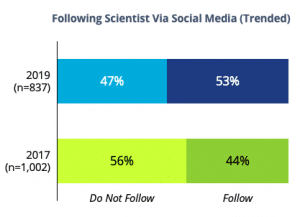Digital Marketing: Life Science Influencers, Experiential Marketing, and Smart Instrumentation
Digital marketing is the art and science of promoting products and services using a variety of digital channels to target prospects at the right time through their preferred channel. Scientists access these
Influencer Marketing
Beyond sporting new clothing, make-up, and other fashion and household related items, influencer marketing is set to play an important role in the life science market where a colleague’s product recommendation has always been exceptionally important. Influencer marketing is about cultivating relationships with personalities who influence the company’s targeted audience. In the life sciences, these personalities can include prominent scientists, conference speakers, science writers and bloggers, and longtime customers.
Our studies showed that more scientists are following their fellow colleagues in 2019 than they were two years ago. Reasonably, LinkedIn and ResearchGate have been the most prominent platforms for influencers; however, Facebook now plays a more important role compared to 2017. Millennials and scientists from the APAC region are driving this change. But it is important to note that influencer marketing starts with a thorough understanding of the company’s customer base. Locating those with the most influence is not simply a matter of consulting grant and publication data, but identifying those individuals already predisposed to expressing their opinions through speaking engagements, articles and presentations online.
Influencer marketing is important because it adds an authentic, non-commercial voice to content and 
True influencers are approached regularly by vendors hoping for them to review and/or recommend their products and increase sales. Helping these influencers first goes a long way to generating trust by solving a problem for them at no cost through experimental advice or the loan of an instrument that will generate data that can then be used in subsequent marketing.
Experiential Marketing
What is the best part about getting a “free sample”? It’s the ability to test how well the product works for you. Experiential marketing has long been a successful element of consumer marketing based on the idea that “try before you buy” helps customers feel more educated about a product and reduces their perception of risk. In the life sciences, experiential marketing is also more memorable when following an in-lab demo or returning home after a scientific conference. The range of tactics is virtually unlimited, but they share the common characteristics of being immersive, informative and fun.
So what are the most engaging forms of experiential marketing that provide a positive impact? Our analysts found that for some respondents, on-site live demos have consistently had the most impact over the last two years. While they resonated well across all age groups globally, they resonated particularly well with the boomer generation. Besides having a positive impact, those who participated in live demos were also very likely to share their experience with colleagues in person as well through more formal avenues.
Scientists continue to see the value of live product demonstrations at conferences and in their lab, and increasingly see these as more positive. Receiving an instrument at the lab site also had high participation with a high positive impact.
Those who participate in these demos are those who eventually become influencers and with whom you should nurture a relationship.
Smart Instrumentation
How often do you use your smart phone? What if you were able to use it to improve your workflow? Smart instrumentation for life sciences include platforms that use artificial intelligence and machine learning algorithms to improve research and decision-making.

Now not only can scientists monitor their PCR runs on their smartphone, but they can also purchase machines that alert them when there is an error (i.e, when an HPLC run stops). While sharing data seems to be the lowest priority for scientists when considering smart instrumentation, it shouldn’t be considered unimportant. Being able to add their personal results to the data produced by their peers can help solidify and draw additional conclusions through this larger available data set. Even if scientists aren’t interested in data-sharing capabilities, they still value guidance and resources from scientists they follow. Based on feedback:
- Life scientists are most interested in learning about protocols and experimental advice from the scientists they follow. Interest in these types of content has grown with increased use of ResearchGate, a platform where these kinds of content are frequently shared.
- Life scientists look first to their colleagues for information on products, followed by scientists they follow on social media. Advertising for life science products, sales representatives, and product brochures were consulted after.
Therefore, it is reasonable to conclude, that although aspects of workflow and interpretation are highly valued and useful, shared resources from perceived credible sources (colleagues and scientists followed) would be considered very valuable.
Our report goes on to detail how scientists perceive visual content, the ethics and believability of sponsored content, executive branding and its recognition, customer engagement, and mobile marketing. Digital marketing to life scientists is constantly evolving with the availability of new technologies and changing preferences of generations. For additional sample data and a complete table of contents click here.



